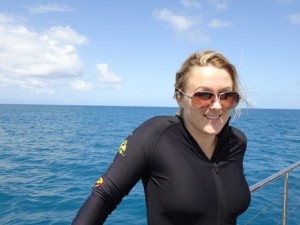Last time, we examined some basic information regarding one of the Far North’s most notorious summer visitors, the Bluebottle Jellyfish. Stings from any kind of jellyfish are extremely rare during the so-called “stinger season” and blue bottles make up the majority of instances out at the reef. Next, we’ll look at another type of stinger that, while very, very rare out at most reef locations, deserves a mention: Irukandji.
The term Irukandji refers to an Australian Aboriginal tribe that inhabited the Palm Cove region of northern Queensland where the Irukandji occurs most often. Irukandji jellyfish are small jellyfish that inhabit marine waters of Australia and their stings cause symptoms collectively known as Irukandji syndrome. Irukandji syndrome includes an array of systemic symptoms, including severe headache, backache, muscle pains, chest and abdominal pain, nausea and vomiting, sweating, anxiety, and high blood pressure. Unlike most jellyfish, that only have stinging cells on their tentacles, Irukandji have stinging cells all over their body; while the animal itself is quite small (5-25 centimetres) this added surface area of stinging cells increases the potential for contact.
Irukandji:
Likelihood of being stung: Extremely Low
Danger of sting: Moderate
The initial sting may not be severe, and is often described as similar to a mosquito bite, with symptoms of Irukandji syndrome typically taking 30 minutes to appear. First aid for suspected Irukandji stings includes removing the victim from the water and placing them in a safe location, with someone monitoring them for a minimum of 45 minutes. If symptoms such as muscular pain, headaches, vomiting, high blood pressure or chest pain occur, call for help – dial 000 for an ambulance. Pour vinegar onto affected area and carefully remove any tentacles. In severe cases, CPR may be required.
The best method of prevention of getting stung by one of these organisms is, as mentioned in the last segment, using a stinger suit, also called a sun suit. These full-body lycra suits are especially effective against Irukandji stings as Lycra is a synthetic, non-organic compound; when an Irukandji jellyfish comes into contact with the material, it does not register anything is living and will therefore not sting.
It is important to remember that, while stings from Irukandji can be quite serious, stings are extremely rare and unlikely. In the recorded history of Irukandji stings, there have only been two reported deaths; the last one in 2002 sparked a state-wide awareness campaign that has made stings by Irukandji an even rarer occurrence. So, with a little knowledge and prevention (and a stinger suit), you can rest easy when you head out to the reef for a day of fun snorkeling and diving on the Great Barrier Reef.

